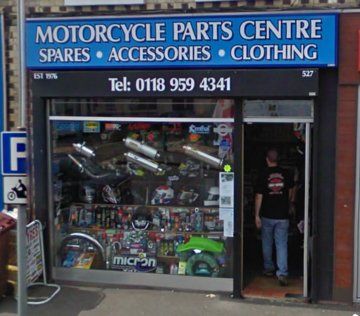Go To Our Motorcycle Shop for Expert Advice and Quality Products
Go To Our Motorcycle Shop for Expert Advice and Quality Products
Blog Article
Understanding the Crucial Parts of a Motorbike: A Comprehensive Guide for Fanatics
For motorcycle fanatics aiming to elevate their riding experience and guarantee their bikes run smoothly, recognizing the crucial components of a bike is extremely important. Each component, from the engine's intricate workings to the vital role of the stopping mechanisms, not only impacts performance yet additionally safety and comfort. This overview will certainly walk through the essential parts that every cyclist must recognize with, making it possible for notified selections in both upkeep and potential upgrades. As we begin this expedition, one must ask: just how does each component communicate to develop the smooth ride every enthusiast seeks?
Engine Components

The camshaft plays an essential function in regulating the timing of the engine's valves, making certain the exact opening and closing needed for reliable fuel and air consumption, along with exhaust expulsion. This timing is essential to preserving optimum engine performance and effectiveness. Additionally, the carburetor or fuel injection system, relying on the motorcycle design, is accountable for mixing air with gas in the appropriate proportion for burning.
The cooling system, either air or liquid-based, works to preserve the engine's temperature level within functional limitations, preventing overheating and ensuring longevity - mx parts nz. Each component, meticulously made and integrated, adds to the seamless operation of the engine, defining the bike's power output and overall performance
Transmission System
Important to the bike's functionality, the transmission system makes certain effective power transfer from the engine to the wheels. This system makes up numerous essential elements, consisting of the clutch, transmission, and last drive, each playing an important function in equating the engine's power right into motion. The clutch, commonly run by a hand lever, offers to engage and disengage the engine from the transmission, enabling smooth equipment adjustments and controlled velocity.
The gearbox, usually referred to as the transmission appropriate, has a collection of gears that motorcyclists can by hand move through to readjust the bike's speed and torque outcome. These gears are organized in a series that allows the motorbike to increase smoothly and maintain optimum engine performance across numerous speeds. Many motorcycles use a consecutive gearbox, calling for the rider to shift equipments in a fixed order.
Braking Systems
While recognizing the transmission system is vital to taking advantage of a bike's power, similarly important is the capacity to control and quit that power successfully, which is where braking devices enter into play. Brakes are critical for safety and performance, giving the cyclist with the necessary control to navigate different surfaces and problems. Commonly, motorbikes feature 2 kinds of stopping systems: disc brakes and drum brakes.
Disc brakes are much more common in modern-day motorcycles due to their informative post remarkable performance. This system uses much better warm dissipation, regular performance, and improved quiting power, especially in wet problems.
Alternatively, drum brakes, though much less typical, are still found in some bikes. They function by pressing brake shoes versus the inner surface of a drum affixed to the wheel. While generally much less reliable in heat dissipation and quiting power, drum brakes are less complex and a lot more cost-effective.
Understanding these stopping systems' subtleties allows cyclists to maintain their bikes effectively and value the engineering that ensures secure and efficient stopping.
Suspension and Guiding
Suspension and guiding systems are vital elements that dramatically influence a bike's handling and experience comfort. The shock absorber, being composed of forks at the front and shock absorbers at the rear, soaks up road irregularities, improving security and control. Front forks, commonly telescopic or inverted, compress and rebound to mitigate effects, while rear shock absorbers preserve tire contact with the roadway, vital for grip and security.
Steering, centered around the handlebars, links the biker to the bike's directional control. The steering head bearings guarantee smooth procedure, permitting precise maneuverability. Correct placement and maintenance of these bearings are crucial for foreseeable guiding response and decreasing biker exhaustion.
The suspension's adjustability is an additional essential facet; preload, damping, and rebound settings permit modification to fit different riding styles and conditions. This adaptability is crucial for maximizing performance, whether navigating urban streets or dealing with tough tracks. Developments like electronic suspension systems offer real-time modifications, enhancing ride top quality across varied surfaces.

Electrical Solutions
After guaranteeing a smooth and regulated adventure with efficient suspension and guiding systems, interest turns to the electric systems, a critical aspect of contemporary bikes. These systems play an essential duty not useful source just in beginning the engine but likewise in powering numerous elements that boost the performance and security of the motorcycle.
At the heart of a motorbike's electrical system is the battery, which stores electric energy required for beginning the engine and powering auxiliary systems - motox parts nz. The alternator or generator, coupled with the rectifier-regulator, makes certain the battery remains billed while the bike is in procedure, transforming mechanical power into electric power and preserving voltage levels
The ignition system, one more critical element, is accountable for sparking the air-fuel blend in the engine's cylinders. Modern motorbikes frequently make use of a digital ignition system, using higher efficiency and integrity compared to typical systems.
Illumination systems, including headlights, tail lights, and indications, are likewise important, making sure visibility and safety for the biker. Extra electronic elements such as sensing units, control systems, and displays add to sophisticated attributes like fuel shot management, anti-lock braking systems (ABS), and digital control panels, better boosting the riding experience.
Final Thought
A comprehensive understanding of a motorbike's necessary elements, consisting of the engine, transmission system, braking devices, suspension, steering, and electrical systems, is crucial for enthusiasts aiming to maximize safety, convenience, and performance. Proficiency of these elements enables notified decisions concerning upkeep and upgrades, eventually boosting the riding experience. By incorporating this knowledge, motorcyclists can guarantee their motorbikes operate at peak effectiveness and reliability, consequently maximizing both satisfaction and long life of their vehicles.
For motorcycle fanatics looking to raise their riding experience and ensure their bikes run efficiently, understanding the crucial components of a motorbike is vital.Integral to the bike's performance, the transmission system makes certain reliable power transfer from the engine to the wheels.While recognizing the transmission system is key to using a motorcycle's power, equally vital is the capability to manage funky helmets and quit that power properly, which is where stopping devices come into play. Commonly, bikes feature 2 types of braking systems: disc brakes and drum brakes.
A detailed comprehension of a bike's essential parts, including the engine, transmission system, braking systems, suspension, guiding, and electrical systems, is crucial for enthusiasts aiming to enhance performance, comfort, and safety and security.
Report this page